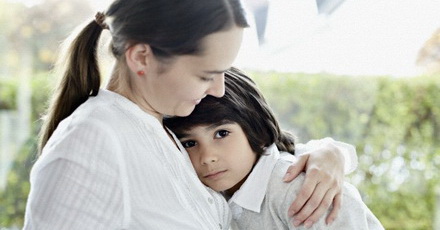

Normal Anxiety

What's Normal Anxiety
Even in the best of situations, all children experience some anxiety in the form of worry, apprehension, dread, fear or distress. Occasional nervousness and fleeting anxieties occur when a child is first faced with an unfamiliar or especially stressful situation. It can be an important protection or signal for caution in certain situations. In fact there are specific expected fears that accompany each stage of child development.
Anxiety: Normal and Necessary
From toddlers to teens, life's challenges may be met with a temporary retreat from the situation, a greater reliance on parents for reassurance, a reluctance to take chances, and a wavering confidence. Typically these concerns will resolve when the child learns to master the situation or the situation changes. Incorporating their newfound abilities, whether it is mastering a new school, the neighborhood pool, taking tests, encountering dogs, kids move on from their fears and have no lasting ill-effects. Parents can facilitate a child's successful adjustment to a new challenge by: (1) being accepting of the child's concerns, (2) listening to the child's perceptions, and gently correcting misinformation, and (3) patiently encouraging a child to approach a feared situation one step at a time until it is becomes familiar and manageable.
Typical Childhood Fears
Infancy
In response to a growing ability to differentiate familiar faces (parents) from unfamiliar, stranger anxiety (clinging and crying when a stranger approaches) develops around 7-9 months and typically resolves by end of first year.
Early Childhood
As a healthy attachment to parents grows, separation anxiety (crying, sadness, fear of desertion upon separation) emerges around one year and improves over the next 3 years, resolving in most children by the end of kindergarten. As children's worlds expand, they may fear new and unfamiliar situations, and real and imagined dangers from big dogs, to spiders, to monsters. Children from age 3-6 are trying to master what is real and what is not, and until this is resolved, they may have difficulty with costumed characters, ghosts, and supernatural beings. While trying to master fears of what could be they may struggle with the dark, the basement, closets, and under the bed. As a child learns how to manage and put aside these fears, their ability to sleep alone will be secured.
School Aged Children
Each year, with access to new information, children begin to fear real world dangers-fire drills, burglars, storms, illness, or drugs. With experience, they learn that these risks can exist as remote, rather than imminent dangers. In middle school, the growing importance of social status leads to social comparisons and worries about social acceptance. Concerns about academic and athletic performance, and social group identification are normal. Learning about various physical and mental health diseases in school may lead to some temporary concerns about risk and safety. Teenagers continue to be focused on social acceptance, but with a greater concern for finding a group that reflects their chosen identity. Concerns about the larger world, moral issues and their future successes are common.
When You Should be Concerned
Anxiety is considered a disorder not based on what a child is worrying about, but rather how that worry is impacting a child's functioning. The content may be "normal" but help is needed when a child is experiencing too much worry or suffering immensely over what may appear to be insignificant situations, when worry and avoidance become a child's automatic response in many situations, when they feel constantly keyed up, or when coaxing or reassurance are ineffective in moving them through. For these children anxiety is not protecting them, but rather preventing them from fully participating in typical activities of daily life-school, friendships, academic performance.
Problem Anxieties
Unremitting anxiety lasting for weeks or months at a time can cause physical distress in the form of headaches, stomachaches, nausea, vomiting and sleeplessness, Difficulty sleeping, reluctance to go to school or elsewhere outside of the child's comfort zone, crying jags, tantrums and clinginess are common. Anxiety can also interfere with a child's concentration and decision-making. An anxious child's thinking is typically unrealistic, catastrophic and pessimistic. They may seek excessive reassurance and yet the benefit of that reassurance is fleeting. Irritability and anger can also be red flags for anxiety when a child becomes frustrated by the stress of worry, or worn down from sleep deprivation. For some children, feeling "different" from other kids can be an additional source of concern.












